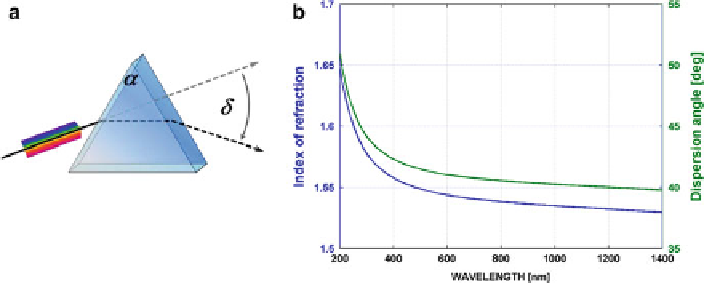Biomedical Engineering Reference
In-Depth Information
Fig. 4.10 a
Prism dispersion depends on the wavelength of light, the prism head angle, and
the dependence of the index of refraction on the wavelength.
b
The dependence of the index
of refraction on wavelength (left y axis) and dispersion angle for a prism with a head angle of
˛ D 60
ı
(right y axis)
Lastly, an advantage of the AOTF lies at the fact that the AOTF acts like a grating,
resulting in two diffracted beams of the orders +1 and -1 at similar angles around
the non-diffracted zero-order unfiltered spectrum transmitted. The two first-order
beams have orthogonal polarizations and, in principle, they can be used by either
directing each order to a different CCD or by combining the two separate images to
be imaged side by side on a single CCD. This will provide an advantage for different
polarization-dependent applications.
4.4.3
Spatial-Scan Methods
In this method, the dispersion of light is achieved by using either a grating or a
prism. The dispersion of a prism is given by
n
p
./
n
0
sin..˛
C
ı/=2/
sin.˛=2/
D
(4.3)
where ˛ is the head-angle of the prism, n
p
./ is the wavelength-dependent index
of refraction of the prism material, and ı is the diffraction angle (Fig.
4.10
).
Figure
4.10
b shows the index of refraction of quartz crystal (left y axis) and the
resulting diffraction angle as a function of the wavelength for prism with a head
angle of 60
ı
(right y axis). As one can see, the difference is significant and provides
the basis for spectroscopy.
A grating can also be used for dispersion (Fig.
4.11
). The diffraction to a certain
angle is strong when the following equation is fulfilled [
29
]:
m
d
sin ˛
C
sin ˇ
D
(4.4)

Search WWH ::

Custom Search